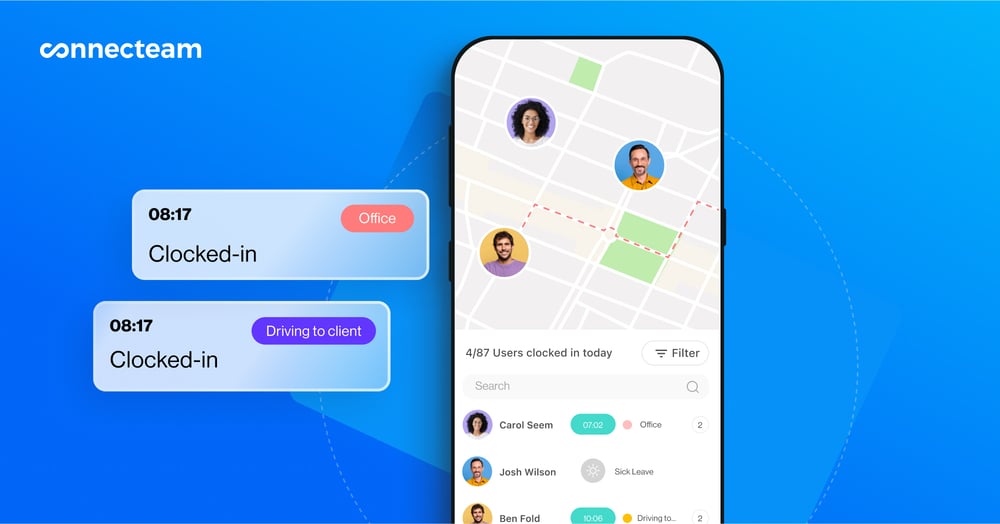Getting employees to show up on time means enforcing rules while showing empathy. I discuss 11 practical tips to tackle the tardiness issue.
Late employees can be a major headache. They can disrupt the team’s rhythm, reduce productivity, and create a hostile atmosphere.
But there are steps you can take to get them to arrive at work on time. In this article, I provide 9 practical tips to motivate employees to be punctual and create a more positive work environment.
Key Takeaways
- Encourage on-time arrivals by establishing clear attendance policies, leading by example, and using shift scheduling software with automated reminders.
- Other strategies include flexible work hours, time tracking systems, and employee training.
- You can also anticipate and address employee challenges, create a positive “morning” culture, reward punctuality, and deter tardiness—all while aiming for solutions that benefit you and your employees.
How To Get Employees To Show Up on Time
Set clear expectations
Craft a comprehensive attendance policy—a clear guide that leaves no room for misinterpretation. Your policy should cover:
- Defined work hours (if relevant) and acceptable arrival windows for different types of work schedules.
- Procedures for notifying managers about tardiness.
- Potential consequences for chronic tardiness.
- Allowances for unforeseen circumstances.
Strike a balance between firmness and flexibility. For instance, you might implement a policy that allows a certain number of late arrivals per quarter without penalty, acknowledging that unexpected situations occasionally arise.
Communicate these expectations right from the start. And, make punctuality a key part of your onboarding process. When you bring new team members on board:
- Walk them through the attendance policy.
- Explain why punctuality is crucial for the team and the company.
- Provide them with any necessary tools or resources to ensure they are arriving to work on time.
Pro Tip
Consider creating a “culture of punctuality” document that outlines rules and the values and reasons behind them. Store these documents in a secure, accessible location—like a company knowledge base.
Lead by example
A leader demonstrating punctuality shows their commitment to company policy and sets behavioral standards for the entire team. This involves more than just walking through the door at the appointed hour. It covers:
- Arriving at work prepared for daily tasks—and starting them promptly.
- Respecting others’ time—for example, by ending shifts as scheduled.
- Being visibly present during work hours.
- Showing good time management throughout the workday.
Leading by example also means being transparent about the challenges of punctuality. Running late due to unforeseen circumstances? Communicate this to your team promptly and professionally.
Use scheduling software with shift reminders
If your employees work shifts or jobs with varying start times rather than fixed schedules, an easy way to help them show up to work on time is by using scheduling software that sends automatic shift reminders. Here’s how it helps:
- Reminders: The software can send notifications to employees before their shifts or jobs—maybe the night before or an hour ahead—so they don’t forget.
- Accessible schedules: Employees can easily check their upcoming work on their phone, reducing any confusion about when they must be at work.
- Custom alerts: Tailor reminder settings according to individual or role-specific needs. For example, field workers who start their jobs at different locations might receive location-based reminders.
Did You Know?
Connecteam’s AI employee scheduler automatically sends shift and job reminders to employees making sure they are always aware of upcoming shifts. This helps to significantly cut down late starts or no shows.
Offer flexible work hours
Traditional 9-5 schedules may not be the most effective approach for every employee. If doing so is applicable and feasible for your business, implementing flexible work hours and/or enabling employees to adjust their schedules to suit their needs can significantly improve punctuality.
Flexible work arrangements can take various forms:
- Flextime: Employees can choose when to start and end their workday within agreed limits. For example, some might prefer to work 7:00 am-3:00 pm instead of the standard 9:00 am-5:00 pm to avoid heavy traffic.
- Compressed workweeks: Employees work longer days in exchange for extra days off. An example is working four 10-hour days to take Fridays off.
- Core hours: All team members are present during specific core hours—such as 10:00 am-2:00 pm—but have flexibility before and after these hours. Meetings and collaboration can take place during core hours.
- Remote work: Employees work from home or another remote location either full-time or part-time. This can reduce or eliminate commuting time, which can help reduce tardiness.
- Results-focused work: Employees work whenever, wherever, and for as long as they choose to—as long as they get their assigned work done.
One employer stated: “I’m in the IT field, and flexible work hours are a normal perks… We don’t care if they work from 8 to 4 or 9 to 5 or something else, as long as they are available from 9 to 3 (except Friday), and that they do deliver the work to the expectation.”
Implement a reliable time-tracking system
An efficient tracking system is crucial for managing employee punctuality effectively. A well-chosen system monitors arrival times and provides valuable data for identifying patterns of tardiness. Employees who know their arrival times are monitored are more likely to be punctual.
When selecting a time-tracking solution, consider the following factors:
- Ease of use for both employees and management.
- Integration capabilities with existing HR and payroll systems.
- Flexibility for accommodating different work arrangements (e.g., field-based work).
- Reporting features that provide actionable insights.
Modern time-tracking systems often go beyond simple clock-in/clock-out functionality. Some solutions like Connecteam offer features like geofencing, which can automatically record when an employee enters the workplace, as well as mobile apps that allow remote workers to log their hours easily.

Reinforce the importance of punctuality through workshops and training
Targeted workshops and training sessions can help employees understand the impact of tardiness and equip them with the skills to manage their time effectively. Consider implementing:
- Time management seminars: Teach practical strategies for prioritizing tasks and managing schedules. For example, you could cover calendar management, transit planning, and the use of buffer times in schedules.
- Punctuality awareness sessions: Highlight the ripple effects of tardiness on team dynamics, work relationships, and company performance. Consider using real-life examples from your organization.
- Wellness courses: Address wellness issues that may contribute to chronic lateness. For instance, employees who struggle with oversleeping might benefit from a course that covers healthy sleep habits.
Pro Tip
Use Connecteam’s training software, which includes features for creating custom modules and quizzes. With the AI Course Creator, describe a topic, and build a complete training course instantly. Employees can access training materials on their mobile phones and in their preferred languages.

Proactively address root causes of tardiness
Often, chronic lateness results from underlying issues. By addressing these proactively—and not just reactively—you can resolve them before they become problems. Here are some common causes and steps you can take:
- Transportation problems: Consider implementing a carpool program or providing information about public transit options. You might also explore the possibility of subsidizing transportation costs for punctual employees.
- Childcare responsibilities: Explore the possibility of flexible start times or partnerships with local childcare providers. You could also consider offering on-site childcare facilities.
- Job dissatisfaction: Use regular check-ins and employee satisfaction surveys to identify and address these issues before they impact punctuality.
- Health issues or disabilities: Ensure employees are aware of any relevant employee assistance programs or health benefits by providing this information during onboarding and making it easily accessible. You should also provide them with information on their rights under labor laws—like the Americans with Disabilities Act and the Pregnant Workers Fairness Act—including their right to reasonable accommodations. For instance, your pregnant workers should know they can request later start times if they’re experiencing morning sickness.
A manager/business owner shared:
I had a worker whose child was disabled, and the drop off at their school required a teacher’s aide and a wheelchair contraption. He would be late every day of the week, and would leave early to ensure that he was there for the pickup after school. He’d then log in from home and knock off the remainder of his work.
I understood the why, and chose to live with the inconsistent timings, because I had a good worker who was responsible and “really good at their job”.
Create a positive “morning” culture
When staff members look forward to coming to work, they’re more likely to arrive on time or even early. Here are a couple of ways businesses with regular 9-5 workdays might increase morale and incentivize on-time arrivals:
- Morning team-building activities: Start the day with a quick, optional team activity that energizes the team. This could be a brief standup meeting where team members share their goals for the day or a short mindfulness session to set a positive tone.
- Breakfast programs: Providing light refreshments at the beginning of the workday can be a powerful incentive for early arrivals. This could be as simple as having a coffee machine ready or offering fruit or granola bars.
That said, creating a positive morning culture won’t work for all teams—but this strategy can be easily adapted for various work schedules. For instance, if your employees work shifts, you might incentivize on-time arrivals with shift-specific activities (e.g., evening shift activities like group workouts) or time-specific refreshments (e.g., lunch programs).
Recognize and reward punctuality
A recognition and reward system for timeliness can reinforce positive behavior and motivate employees to be punctual. Consider these strategies:
- Implement a points-based system where employees earn points for on-time arrivals. They might earn points individually—or you can group them into teams for a team-based points competition.
- Offer tangible rewards such as extra paid time off or prime parking spots.
- Provide public recognition through company-wide announcements or newsletters. For instance, you can implement a “Punctual Person of the Month” award, where early arrivers earn recognition on your company’s internal communications app.
- Include punctuality as a criterion in performance reviews and promotion considerations.
Implement this system consistently and fairly across all departments and levels of the organization. For instance, if your workers all have different numbers of shifts, adjust the points or system so everyone has a fair chance to earn the same number of points.
Also, clearly communicate the criteria for recognition and rewards to all employees.
Did You Know?
Connecteam’s rewards and recognition feature lets you easily acknowledge punctual employees with rewards like gift cards.

Create clever deterrents to tardiness
While positive reinforcement should be your primary approach, you might need some deterrents to discourage chronic tardiness. The goal is to make the consequences of tardiness unattractive to employees while minimizing the impact on your business. Here are some creative ideas:
- Temporary loss of privileges: For instance, chronically late employees might temporarily lose access to the best parking spots, the ability to work from home on certain days, or employee discounts.
- Last pick for desirable shifts: In businesses with shift work, consistently late employees could be placed at the end of the line for shift bids or weekend-off requests.
- Assignment of less desirable tasks: Late arrivals might be assigned to less preferred duties (as long as they’re capable of handling them).
- Requirement to “repay” employees who covered the slack: Make late employees help those who covered for them due to their tardiness—for example, by having those late employees take over the other employees’ end-of-day/shift tasks.
- Requirement to stay late: In some cases, you might require employees to add extra time to the ends of their shifts or workdays, which can help them make up the time they missed.
One Reddit user suggested: “You might have better results if you set up a system that can reward on-time employees as well as other important aspects that some employees do well and some do the bare minimum. Get a proper time and attendance system (doesn’t need to be fancy) and give on-time employees first dibs on requesting time off on holidays if you’re open or first dibs on overtime when it’s available.”
Meanwhile, a sourcing manager for a major airline shared, “If you show up late it better be because you stopped and got donuts. I put this policy in place years ago and [employees] still use it. I told them bringing breakfast is the way you should thank your co workers for covering your slack when you are late.”
Pro Tip
Before implementing any deterrents, ensure they comply with local labor laws and your company policies—for instance, by having your HR team review them.
Aim for win-win solutions
Inclusive self-motivated prevention is often the best way to increase employee buy-in and commitment to punctuality by engaging them in creating solutions to tardiness.
Consider these strategies:
- Hold open discussions: Organize team meetings or 1:1 sessions where you encourage employees to share their challenges with punctuality and ideas for improvement.
- Collaborative policy-making: Involve employees in crafting or refining attendance policies.
- Employee-driven incentives: Ask your team which rewards would motivate them to consistently arrive to work on time.
- Self-made rules: Encourage employees to set their own punctuality goals and the consequences they’ll face if they don’t meet them. Ensure that any self-made rules or consequences comply with labor laws and company policies.
Thila Suppiah, an HR Leader, emphasizes this approach:
Before you can implement anything – get the buy off of the employees. Have an open agreement where you have a win-win situation, allow for flexibility with some measurement in place. Give them the opportunity to also set some self-made rules which they have to honor.
Motivate Employees To Be Punctual With Connecteam
Connecteam is an all-in-one employee management app designed to help businesses ensure their teams show up on time, every time. By providing tools that streamline scheduling, communication, and time tracking, Connecteam makes it easier for managers to promote punctuality and for employees to stay on schedule.
With Connecteam’s automated shift reminders, employees receive timely notifications directly on their smartphones, keeping them informed about upcoming shifts and reducing forgetfulness. The app’s user-friendly scheduling features allow employees to view their schedules anytime, eliminating confusion about start times or locations. This accessibility ensures everyone knows when and where they’re expected to be.

Connecteam’s reliable time-tracking system includes GPS verification and geofencing, ensuring accurate clock-ins and confirming that employees are at the correct location when they start their shifts. Managers receive real-time updates on clock-ins, enabling them to address any lateness promptly. Additionally, the platform’s communication tools facilitate instant updates and group chats, fostering a team environment where punctuality is valued and supported.

By integrating Connecteam into your daily operations, you’re empowering your employees with the tools they need to be punctual and stay connected. The app’s comprehensive features not only help manage schedules but also enhance overall team performance. Experience the difference Connecteam can make in promoting punctuality and efficiency within your workforce.


